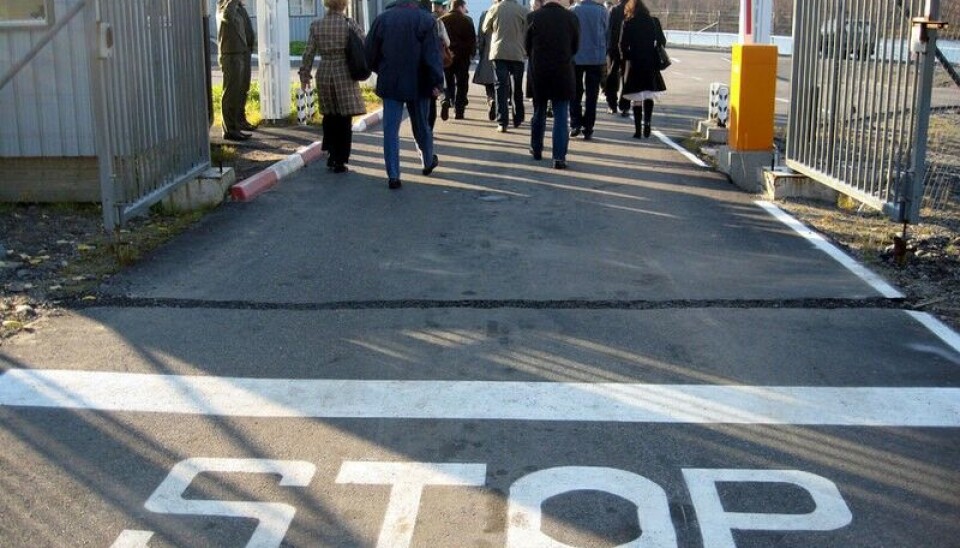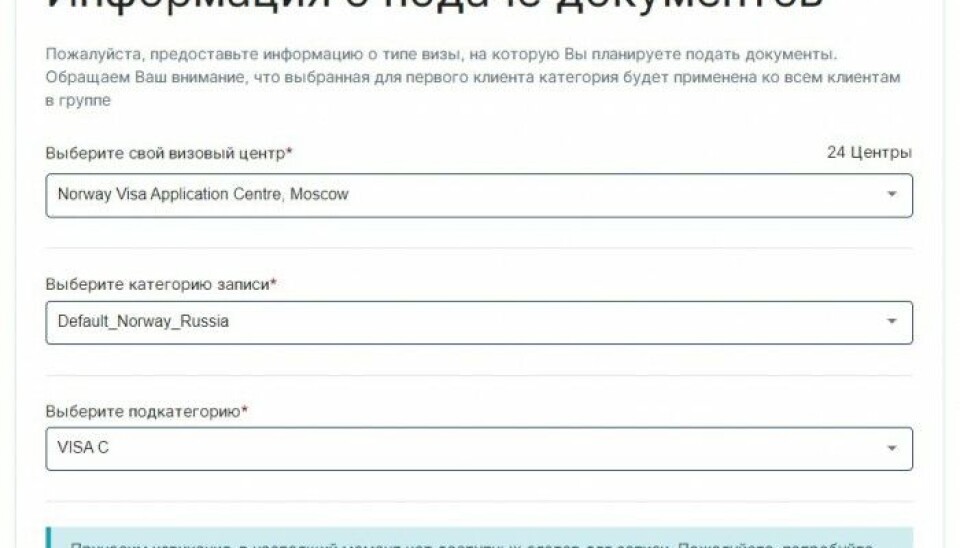
Fewer visas, more sanctions, more expensive insurance. How the border between Norway and Russia is closing
The number of Russians entering Norway is declining. And it will decrease further because of sanctions pressure and visa policy. Travel, which until recently was a routine thing for residents of border regions, will soon become a luxury inaccessible to most. The Barents Observer tried to figure out why.
Norway issued 367 visas to Russians in the first quarter of 2023. The figure is catastrophically low. For comparison, during the three pre-Covid years, Norway issued an average of 1,900 visas to Russians … per month.
At the same time, the number of visa refusals increased. In 2019, just one (!) percent of all Russians who applied for a Norwegian visa could not get it. After the Russian attack on Ukraine, the ratio “slightly” changed – in 2022, one in four visa requests was rejected. Now, according to data provided by the Norwegian Directorate of Immigration (UDI) to The Barents Observer, the refusal rate is even higher.
All of this is a reflection of a trend that can be summed up in one sentence: the border between Norway and Russia is closing. The consequences are already felt by hundreds and thousands of people, and soon their number will increase.
Fighting the bot
“For a creative person, it’s not how much you earn and how much you travel, but how much you are in demand,” says Alexei from Murmansk, a dancer, teacher and coach. He says he has made dozens of trips to Norway over the past decade and a half. He went to festivals, competitions and took part in joint projects.
“In Finnmark, we traveled almost everywhere. People started recognizing us: you walk down the street, they smile at you, say hello,” Alexei recalls. “And we had projects, and we had Norwegians perform on our side. We performed in Norway, and they performed in Russia. It was cool.”
Alexei’s five-year Norwegian visa expires in June, and he does not expect to get a new one. He wants to go to Norway at least once more, despite the difficulties – the inability to use a Russian bank card or book accommodation.
“I am not interested in politics. The situation is unclear, and where it will lead is unclear. I am a pawn in this big game. Of course, everyone wants to return to the old time …” says Alexei.
The Barents Observer has previously reported that Norwegian authorities have effectively stopped issuing tourist visas to Russians. Although Norway has not announced any official ban, like Finland did, they simply do not issue entry permits to tourists.
In practice, even those who intend to go to Norway to visit their family cannot get a visa. It is impossible to register at the visa centers. Everyone who wants to apply for a visa for their children or parents complains about the lack of available slots.

In February 2022, the Russian business daily Kommersant wrote about how appointment slots in visa centers are intercepted by bots and then resold. This activity is not illegal, and experts say it is extremely difficult to fight it. As a result, people who would like to go through all the procedures on their own are forced to turn to intermediaries and pay them money.
The Barents Observer tried to contact companies “helping” with the visa application. Such offers can be found, in particular, on popular classifieds sites. One of the ads explicitly stated that they were using a bot for registering with a visa center. But not always.
“There is no bot for Norway. It is very expensive to make, and Norway is not the kind of destination that will make it worth the while,” a company employee said.
The person we spoke to suggested getting a visa of another Schengen state. However, for Russians who want to visit their family in Norway, this is a bad option. Svetlana, a retiree with a Finnish visa, decided to visit her son, who lives in Kirkenes. At the Norwegian border, she was interrogated: an immigration officer expressed bewilderment at the fact that the final destination of the trip was Norway, not Finland. The woman was threatened with having her visa canceled. As a result, she really had to go through Norway to Finland so as not to violate the law.
“I have already written here many times that at the border you need to clearly state that you are going to the country that issued the visa. And if there have already been entries, then you need to have confirmation that you had a visa there. I’ve been in situations like this and this is really a violation of the Schengen code when you travel on a visa of another country,” says a user the “Russian Federation-Norway Border” chat on the Telegram messenger app.

According to a resident of Murmansk who makes a living by transporting people, all of these factors have lead to a dramatic decrease in the number of tourists.
“In two months, passenger traffic fell by about half. This is due precisely to the fact that visas are running out. Some will say that they still travel; but these are those who received Spanish, Italian or French visas. If we talk about Norway specifically, then it is about twice as low,” says the man who asked not to be identified.
Ruinous insurance
Another issue that will affect the number of travelers is car insurance. From June 1, so-called “green cards” will no longer be issued to Russians. This means that car owners who intend to travel to Norway will have to choose between looking for policies from European insurers or buying insurance right at the border.
According to St. Petersburg-based Fontanka news outlet, some brokers offer Polish or Lithuanian policies. Insurance for 30 days for a passenger car costs €80-90, while a year-long policy is between €375 and €470. For comparison, a 30-day Russian “green card” now costs about 6,000 rubles (about 70 euros).
Policies are also sold at the Norwegian border. According to the telegram channel Bloger51, car insurance for a month will cost NOK900 (6,600 rubles). The price of an annual policy is NOK6,840 or more than 50,000 rubles.
“But this is now, and from June 1, prices will rise multiple times. As stated on the website of the Norwegian customs, insurance for a passenger car will cost NOK2,300 (RUR17,000) for a month or NOK17,000 (RUR126,000) for a year. And the owners of vans will have to pay NOK52,000 (almost RUR400,000) for the annual policy.
There is a specific emphasis on the fact that prices for cross-border insurance are rising for the first time in 13 years. “The new prices reflect both adjustment for inflation and geopolitical changes,” the press statement says.
Against this background, insurance at the “old” prices is in high demand. A police source told BO that the number of sales at the Norwegian border increased several times in May.
The Barents Observer spoke to some people who earn money by transporting people across the border and they believe that expensive insurance will drive passenger traffic down even further. The average salary in Murmansk is now less than 60,000 rubles per month. Few people will risk parting with a sixth of their annual income for an insurance policy for foreign visits. That means that only wealthy people will be able to afford to travel. Also, the cost of transportation will inevitably increase.
Another limitation is an effective ban on the operations of private carriers. Sergei, a resident of Murmansk, had been taking people to Kirkenes for many years, but in early May he was forbidden to do so and he was threatened with having his visa canceled. The general rule is this: if you enter Norway with a passenger, you must have that same passenger with you on the way back. That means, that now you can come to Norway from Russia only with the help of large accredited carriers. This will also affect the cost of services: reduced competition never leads to lower prices.
“If left without work, they’ll go to war”
The rules for the transportation of goods are also being tightened. The Barents Observer has already reported how the new sanctions are hitting Russians who had been delivering car parts from Norway. Some, however, try to carry various goods – and fail.
Driver Sergei had an expensive car part confiscated at the border. He knew about the sanctions, but decided to act in the old fashioned way: to ask the border guards what can be transported and what cannot. It did not help.
“The rules change every day. Yesterday it was possible, today it is impossible. Now they say that you can carry some plastic parts that are not related to the engine. But no one knows what will happen at the border. You start asking questions, they answer you: “We will now take away your visa.” People say they [border officers] have never been so merciless. We never saw anything like that,” the man complained.
The Murmansk resident claims that now the border guards confiscate goods they had never paid attention to before. For example, that same Sergei had a wooden decorative cutting board and a birch bark box confiscated when entering Norway: he was bringing them in as gifts.
Grassroots trade between the border regions has existed for many years, says Aleksey.
“Everyone went to Kirkenes, to Finnmark. They bought goods and opened shops with Finnish and Norwegian products. And things were going well for them, truth be told.”
Trade continued even after the start of the war and the imposition of sanctions, but now, according to the man, “the plug’s been pulled”. It’s difficult to estimate how many people were left without income. It’s just as difficult to predict the consequences of this.
“No one will try to adjust, life has stopped. They will go to war, by the way”, believes a Murmansk resident working in transportation. “Do you know how many people go there just to earn money? That’s what they say: what else is there for me to do, I have a family, I’ll go “work” … That’s the horror of the situation.”















